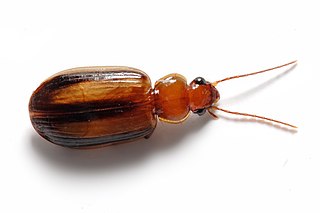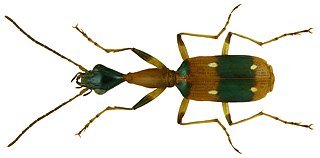
Ant spiders are members of the family Zodariidae. They are small to medium-sized eight-eyed spiders found in all tropical and subtropical regions of South America, Africa, Madagascar, Australia-New Guinea, New Zealand, Arabia and the Indian subcontinent. Most species are daytime hunters and live together with ants, mimicking their behavior and sometimes even their chemical traits. Although little is known about most zodariids, members of the genus Zodarion apparently feed only on ants; a number of other genera in the family are apparently also ant specialists.

Amblytelus is a genus of ground beetle including 44 species distributed through southern Australia, including the Southwest and along the east coast up to North Queensland.
Helluosoma is a genus in the beetle family Carabidae. There are about seven described species in Helluosoma.
Microlestodes is a genus in the beetle family Carabidae. There are about 16 described species in Microlestodes.
Aristolebia is a genus in the beetle family Carabidae. There are more than 20 described species in Aristolebia.

Pericalus is a genus in the beetle family Carabidae. There are at least 40 described species in Pericalus, found in the south, southeast, and east of Asia.
Dicraspeda is a genus in the beetle family Carabidae. There are more than 30 described species in Dicraspeda.
Eudalia is a genus in the beetle family Carabidae. There are about 13 described species in Eudalia, found in Australia.
Mimocolliuris is a genus in the beetle family Carabidae. There are about 17 described species in Mimocolliuris.

Ophionea is a genus of beetles in the family Carabidae. Like others in the family, they are predatory. The genus is mainly found in tropical Asia.
Porocara is a genus of ground beetles in the family Carabidae. There are about five described species in Porocara, found in Australia.
Pseudagonica is a genus in the beetle family Carabidae. There are about 13 described species in Pseudagonica, found in Australia.
Collagonum is a genus in the beetle family Carabidae. There are about 11 described species in Collagonum, found in Indonesia and New Guinea.

Notagonum is a genus in the beetle family Carabidae. There are more than 80 described species in Notagonum.
Dystrichothorax is a genus in the beetle family Carabidae. There are more than 50 described species in Dystrichothorax, found in Australia.
Moriomorpha is a genus in the beetle family Carabidae. There are about six described species in Moriomorpha, found in Australia.
Philipis is a genus in the beetle family Carabidae. There are more than 40 described species in Philipis, found in Australia.
Sloaneana is a genus in the beetle family Carabidae. There are at least four described species in Sloaneana, found in Australia.

Tamopsis is a genus of tree trunk spiders that was first described by B. Baehr & M. Baehr in 1987. Like other members of the family, they may be called two-tailed spiders, referring to two elongated spinnerets. The name is derived from the genus Tama and the Ancient Greek ὄψις, meaning "resembling".

Odacanthini is a tribe of ground beetles in the family Carabidae. There are more than 40 genera and 680 described species in Odacanthini.






